
In July, I had the privilege of hosting the webinar “Rethinking Your Windows 11 Migration with IGEL” alongside IGEL Senior Technology Evangelist Jamie Halscott. During our discussion, Jamie and I explored a number of compelling reasons why IGEL OS 12 should play a central role in any Windows 10 end-of-life strategy. We also highlighted a broader opportunity for organizations to demonstrate forward-looking leadership in managing endpoints.
IGEL CEO Klaus Oestermann and former Citrix CEO / Ferroque Advisory Board Member Mark Templeton have both summarized today’s endpoint management challenges:
“It is now glaringly obvious that the endpoint is the weakest link in overall environment integrity and security.” – Klaus Oestermann
“The urgency around enterprise security has grown exponentially, making security not merely a priority, but a strategic imperative.
The future of enterprise IT lies at the convergence of secure browsers, modern web apps, and streamed Windows apps within a verifiably secure environment. That environment requires us to securely deliver data, applications, and workflows from a seamless grid of cloud and on-premises compute factories… and the Windows desktop OS is no longer the best conduit to deliver services to users.
Traditionally, enterprise IT revolved around the Windows desktop and local apps. But over the past decade, we have seen a radical shift to web apps and services — to the point where, in many organizations, web apps now outnumber local apps.” – Mark Templeton
How does IGEL help you to immediately address these challenges?
The Outcome
When implemented, organizations realize benefits across five core areas that address both immediate and future challenges in supporting endpoints.
IGEL helps enterprises fix endpoint problems and make business work better by focusing on five core values:
- Saves — IGEL reduces both CAPEX and OPEX by extending device lifecycles and minimizing refresh costs.
- Simplifies — IGEL standardizes and streamlines the end-user experience, making it easier for IT to manage and for users to stay productive.
- Supports — IGEL integrates with the critical technologies organizations rely on to deliver applications and support tools securely and reliably.
- Secures — IGEL protects the endpoint and network edge from malware and cyberattacks through its hardened, read-only Linux OS.
- Stability — IGEL removes endpoint complexity and delivers a stable, reliable foundation in today’s fast-changing digital workplace.
IGEL Preventative Security
The IGEL Preventative Security Model is central to saving costs, simplifying management, supporting key technologies, securing environments, and improving stability.
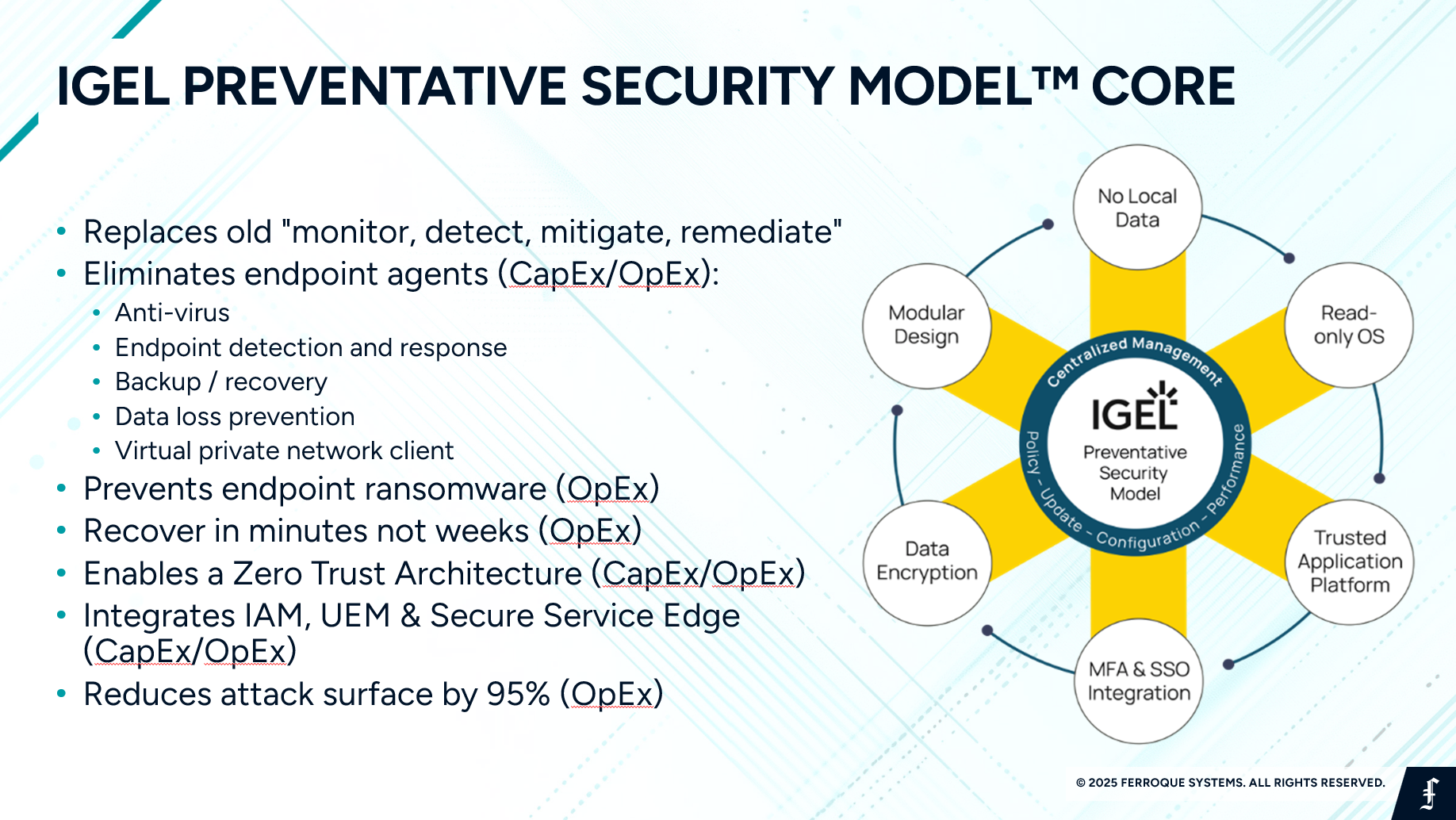
By implementing the IGEL Preventative Security Model, customers are transforming their environments from a reactive stance — responding to enterprise security incidents — to a proactive one that prevents incidents before they occur. Deploying IGEL OS within this model reduces the threat footprint typically associated with Windows endpoints and aligns with Zero Trust principles to block modern threats. Moreover, customers gain verifiable security that is proven, not assumed.
As of this writing (September 2025), IGEL OS remains uncompromised — there are no known incidents of the OS being successfully hacked. Its hardened, read-only core is check summed on delivery to the endpoint, where Secure Boot validation ensures integrity. In the event the OS is damaged or tampered with, the device simply reboots into a known-good state.
From the user’s perspective, only the required applications — such as VDI clients and browsers — are provisioned to the endpoint from a central management system. No local data or user profiles are stored on the device. However, identity management clients can be integrated to support any IdP, passing credentials securely to desktops and applications.
The goal of the Preventative Security Model is to deploy stateless devices that eliminate the endpoint threat surface most vulnerable to ransomware, while enabling organizations to build Zero Trust architectures where the endpoint is no longer the weakest link.
This model also creates a compelling opportunity to redefine endpoint recovery priorities in disaster recovery planning. For example, organizations can deploy dual-boot endpoints capable of running either Windows or IGEL OS. In practical terms, this approach could have dramatically mitigated the CrowdStrike outage of July 2024: affected endpoints would have recovered in the time it takes to reboot, allowing users to resume work with minimal disruption.
IGEL Adaptive Secure Desktop
The Adaptive Secure Desktop (ASD) builds on the IGEL Preventative Security Model™ and introduces five distinct application delivery methodologies to provide users with exactly what they need — no more, no less.
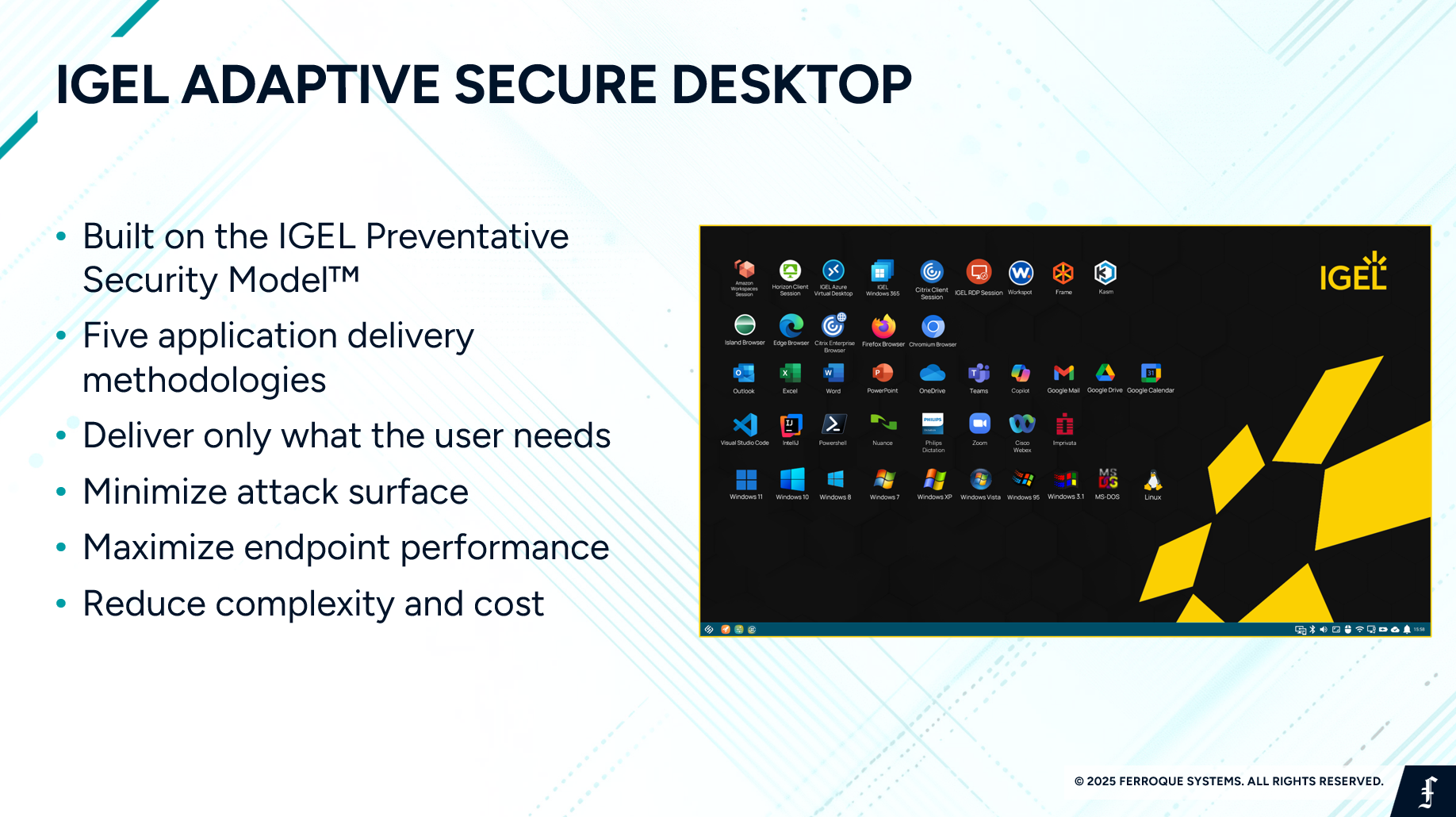
Unlike traditional thin clients or thick client OSes, IGEL OS occupies a unique middle ground. It allows administrators to deliver only the applications required for the user’s role, ensuring a minimal attack surface, maximum endpoint performance, and simplified user experience.
By stripping away unnecessary complexity and overhead inherent in Windows-based endpoints, ASD enables organizations to reduce both cost and risk, while delivering a secure, high-performance workspace purpose-built for the modern enterprise.
IGEL ROI Calculator
If you haven’t already, please reach out to us to walk through the IGEL ROI Calculator in your environment at no cost to you.
Traditional Windows Enterprise environments are expensive to maintain. Deployment, testing, patching, and costs associated with securing a Windows 10/11 estate are estimated to be approximately $1 million per 1,000 Windows devices. Compared to environments where endpoints are enabled with IGEL OS, the cost of maintaining that environment can be reduced by as much as 75%.
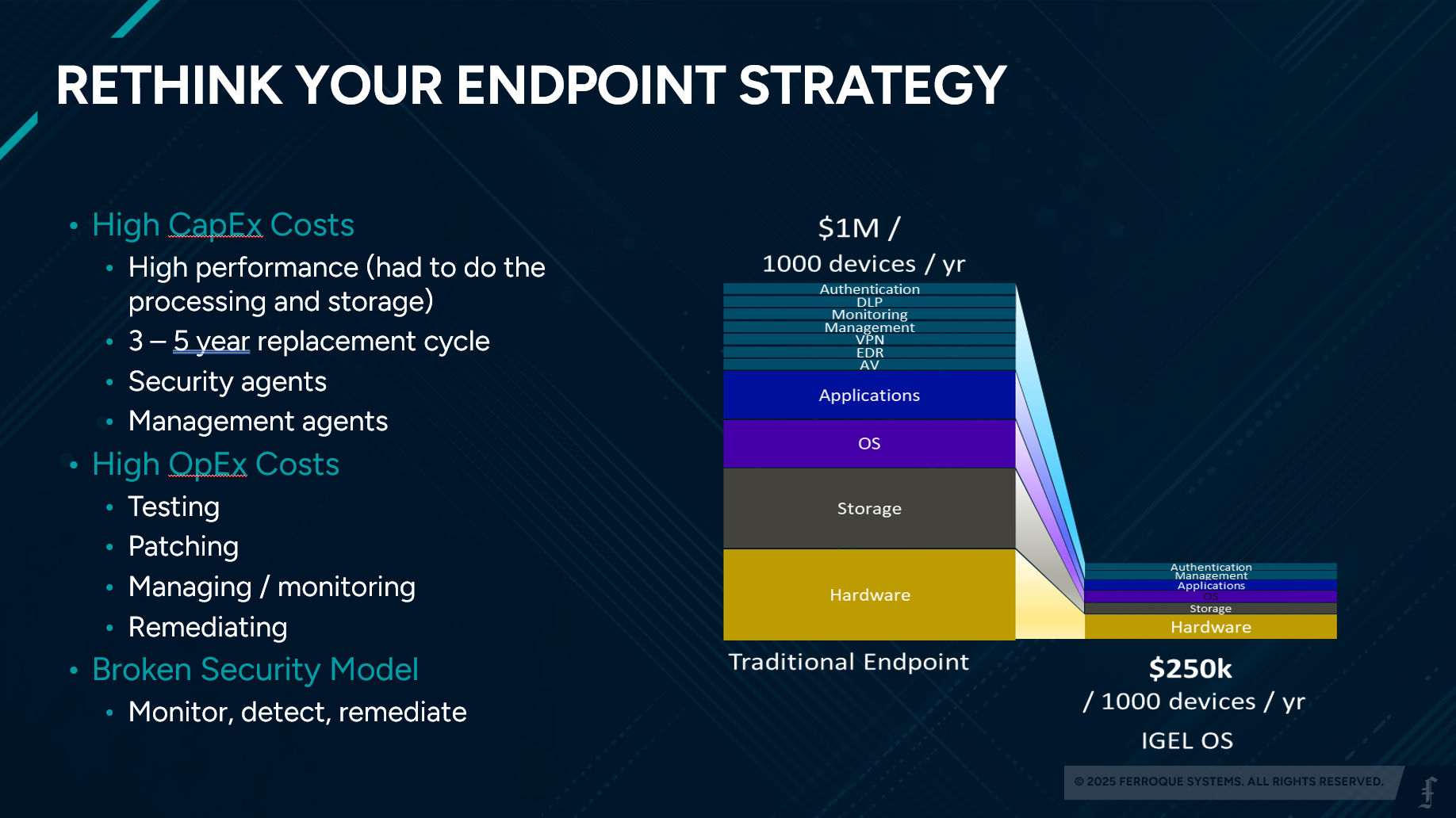
These attainable efficiencies in cost are not merely limited to a few select use cases but are achievable across a number of verticals in organizations of many sizes. In the following use cases, IGEL ROI is measured via:
- Avoiding Recurring Costs
- Cost Reduction
- Improved Productivity
- Risk Mitigation.
See the example below from healthcare: a customer with ~40k endpoints experienced 90% savings in cost to deploy and maintain their IGEL environment over the course of 3 years.
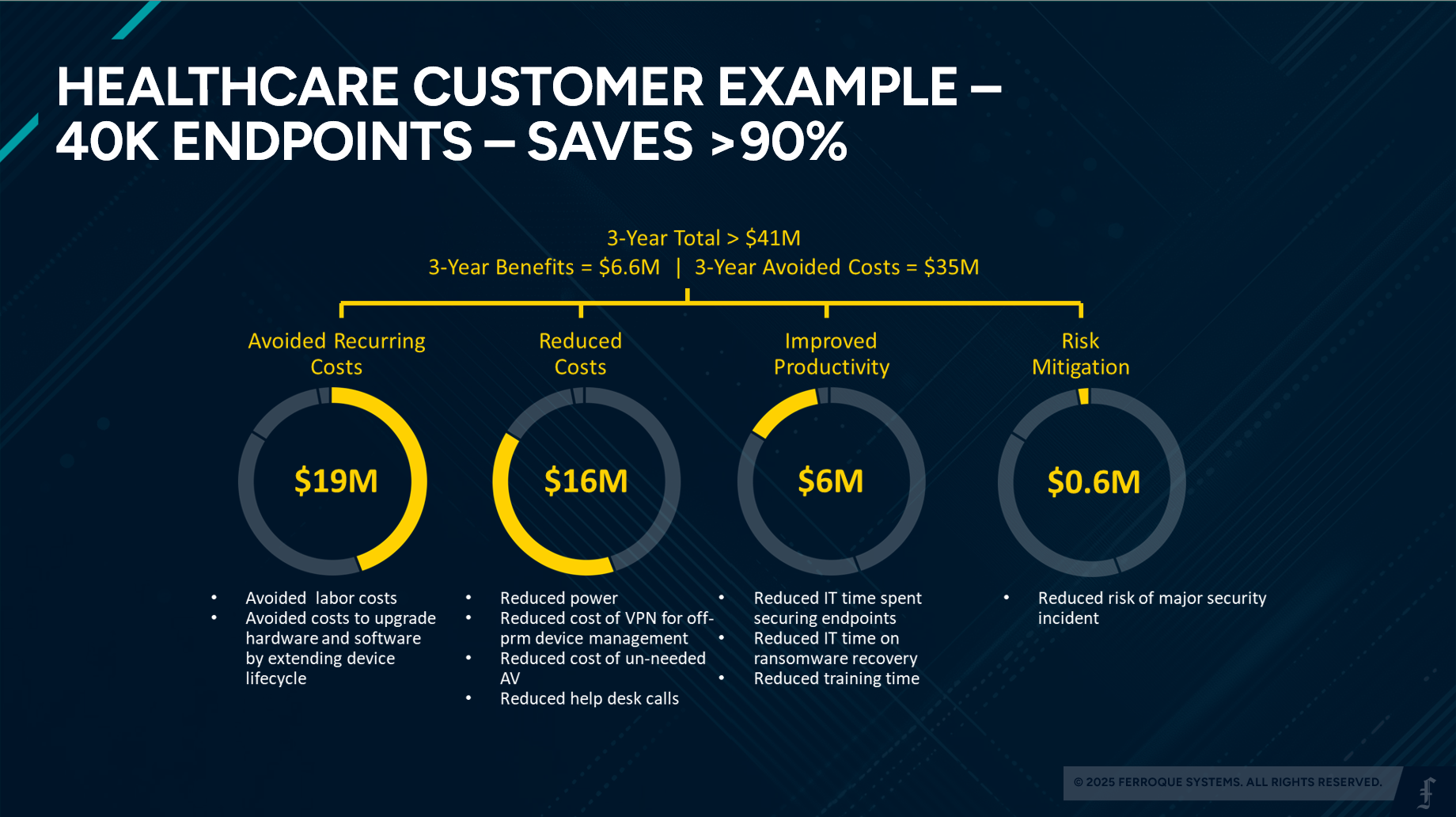
Customers operating in Energy can expect to attain a number of realized values to replace Windows endpoints with IGEL OS. These ROI calculations, realized over a three-year period, included significant value from realized cost reductions and avoidance.
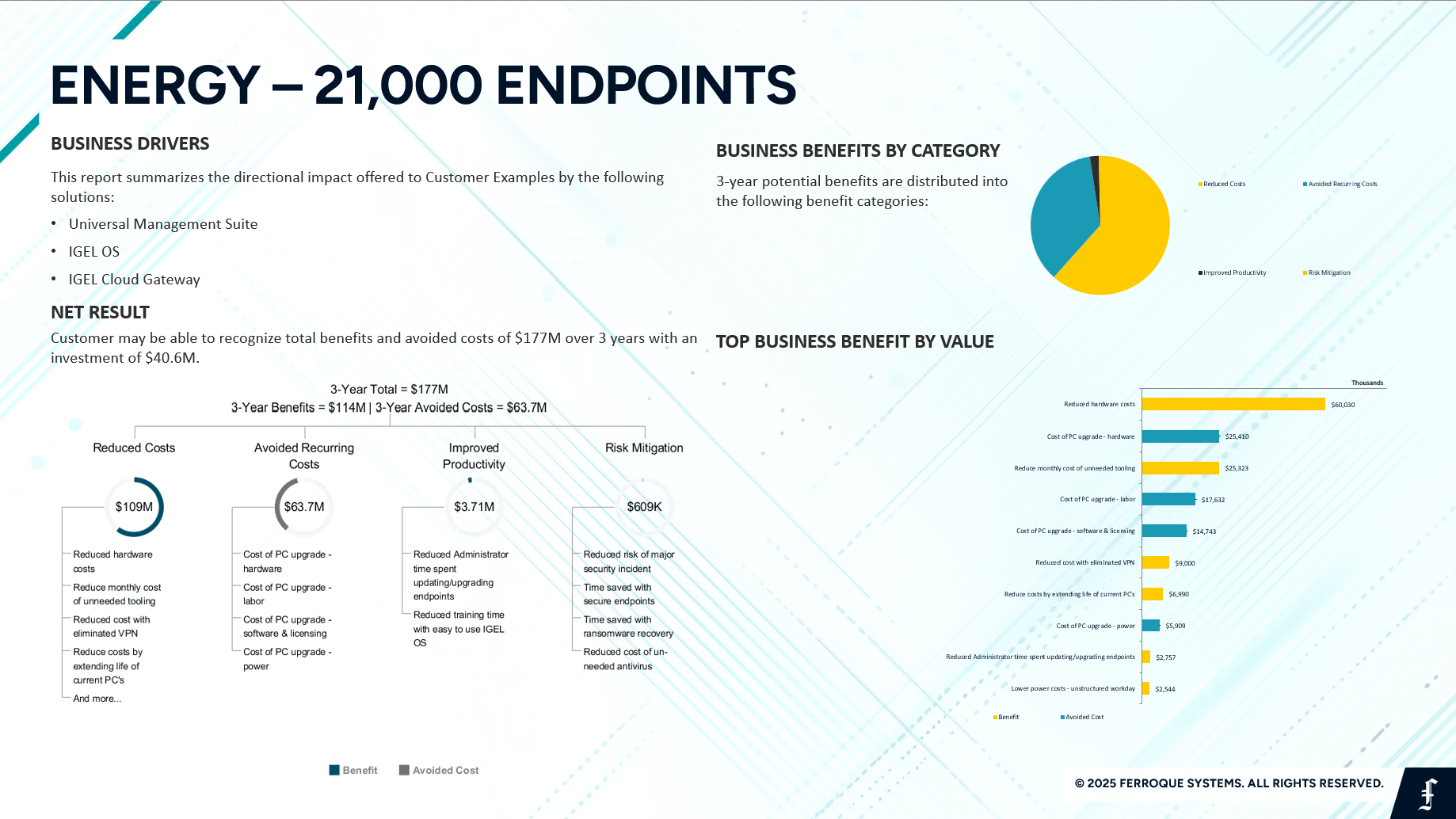
You do not need an environment that supports endpoints in the x10,000s to achieve a significant ROI. In the example below, a finance company realized $1.69 million in cost avoidance with only 1,600 endpoints.
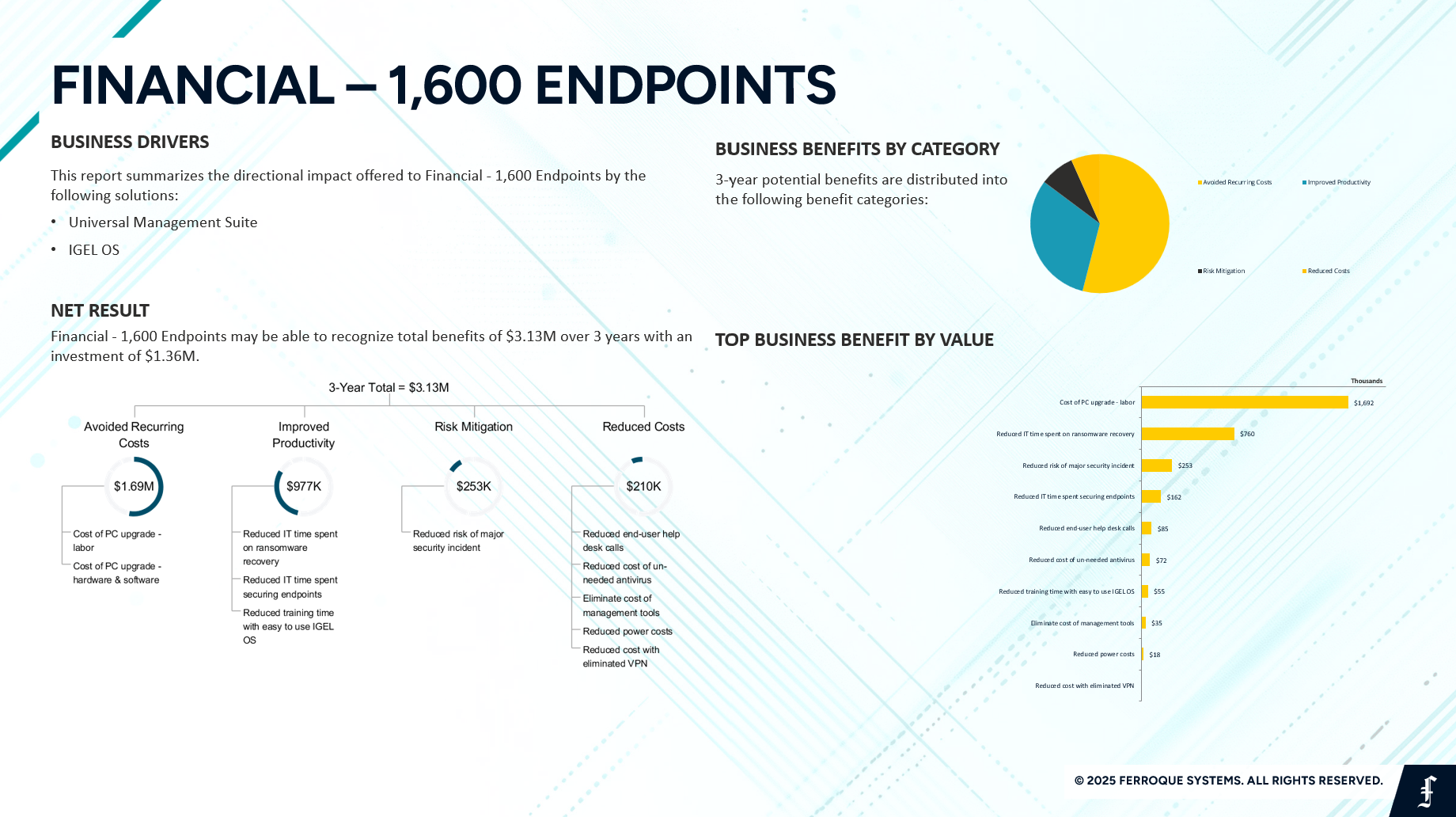
In Conclusion
The Windows 10 EOL milestone that we will realize on October 14, 2025, presents a unique opportunity for EUC stakeholders to exhibit exceptional leadership. The theory that you must upgrade your endpoints to Windows 11 to keep your endpoints operational and supportable is inaccurate.
IGEL OS offers a different path — one that prioritizes security without hardware lock-in, lifecycle extension without e-waste, and cost savings without sacrificing user experience. By decoupling the endpoint from Windows and focusing on secure, cloud-ready access, IGEL enables IT leaders to redirect budget and resources toward innovation rather than forced upgrades.
For organizations facing tens of thousands of endpoints that will not pass Windows 11 readiness checks, the question is not whether IGEL can compete with Windows; rather, it is whether IGEL can provide a viable alternative. It is whether it still makes sense to treat the endpoint as a full Windows PC at all.
Before committing to costly refreshes and licensing escalations, IT leaders should evaluate whether IGEL OS fits their endpoint strategy — not as a short-term workaround, but as a long-term shift toward secure, simplified, and cost-effective digital workspaces.
Regardless of where you are in your Windows 10 EOL planning, Ferroque’s Modern Workspace Practice would love to hear from you and discuss the benefits and operational agility that the IGEL OS can bring to your organization.
If you are running IGEL OS 10 in your organization, we are happy to discuss your endpoints and support your transition to IGEL OS 11. Contact us today to get started or learn more by watching the full webinar.
-
 Jeremy Ingram
Jeremy IngramJeremy has been deploying Citrix and NetScaler products since 2008. A seasoned architect spanning technologies and industries, Jeremy has a passion for deploying Citrix products, which he firmly believes are the coolest bits running in enterprise environments today.








